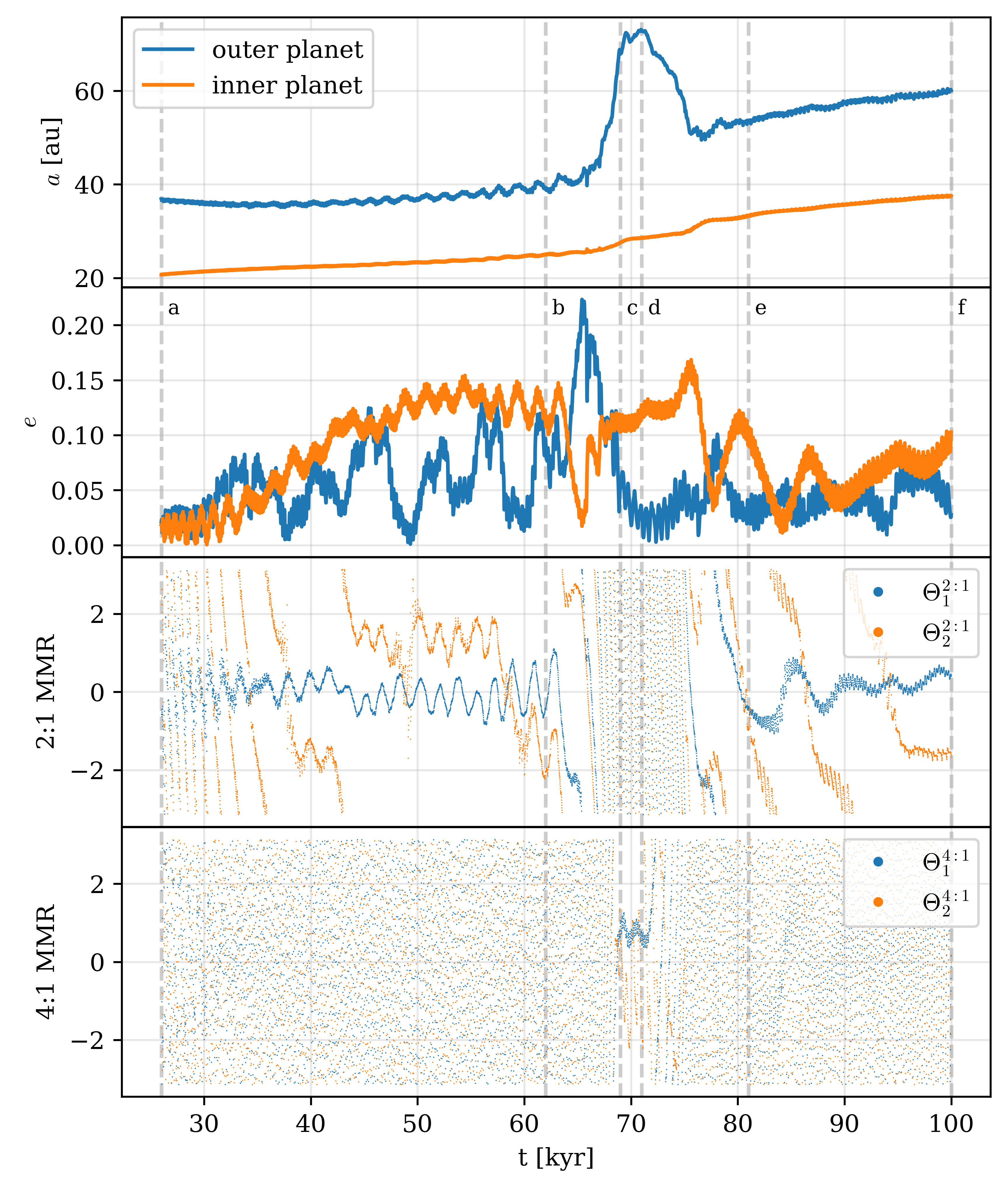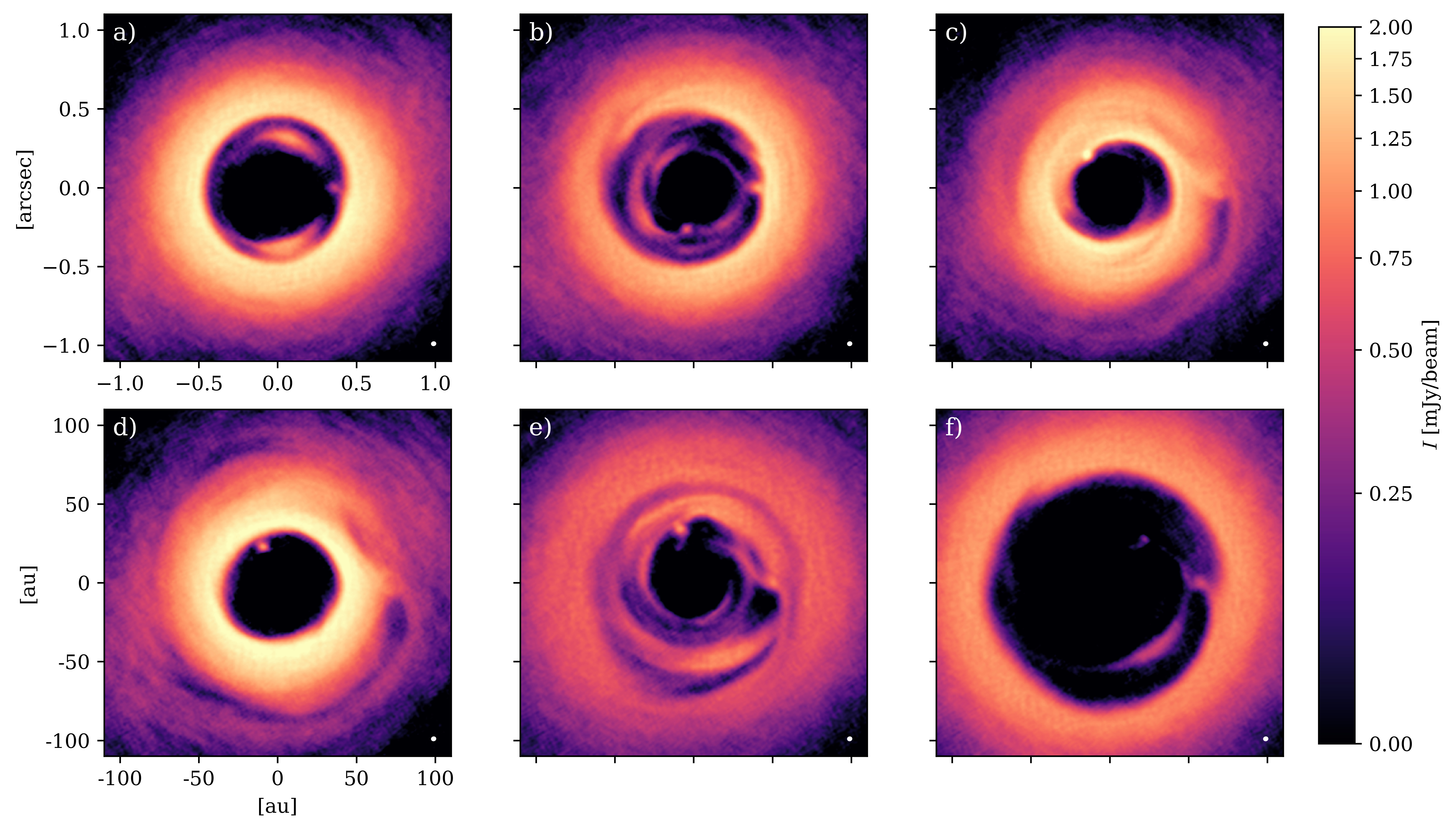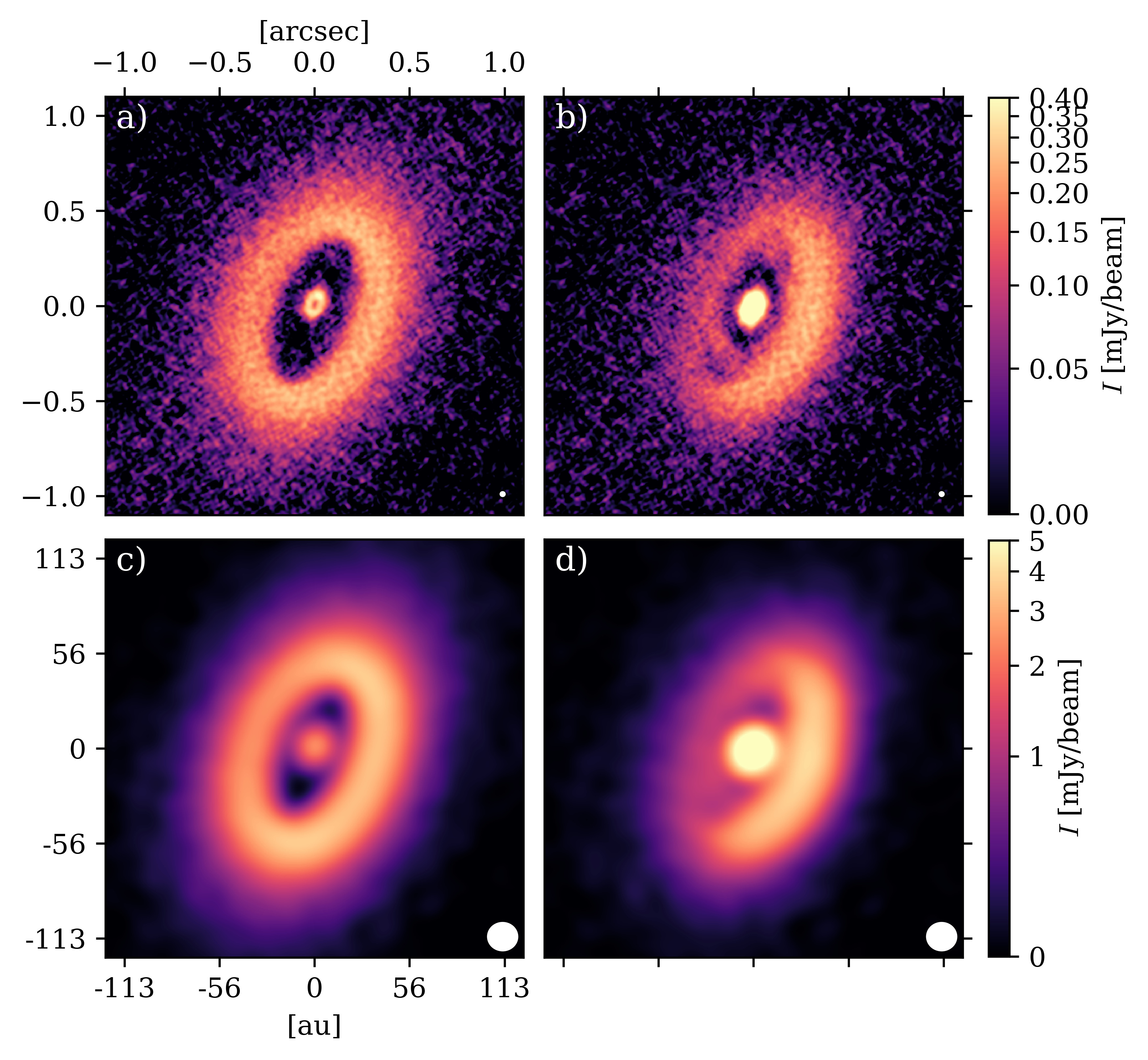Migration Jumps in Transition Disks
Thomas Rometsch 1 , Peter Rodenkirch 2, Wilhelm Kley 1, Cornelis Dullemond 2
1 University of Tübingen, 2 ITA, Heidelberg
Click on images to enlarge them, drag them around and scroll to zoom. Click again to close.
Hover over text with
underscore
to learn more detail. Click on links to jump to other sections.
This work is accepted for publication in A&A. Find the
preprint on arXiv.
Transition disks are protoplanetary disks that are characterized by a deficiency of disk material close to the star. In a subgroup, called Type II transition disks (Owen 2016) , inner holes in these disks can stretch out to a few tens of au while there is still mass accretion onto the central star observed at the same time.
Massive planets are known to carve gaps into their natal disk, moving away material from their orbits. The more massive the planet, the larger the gap. Having embedded massive planets in transition disks is therefore a natural candidate to explain the inner holes. However, large and deep gaps are also considered to hinder mass accretion by forming a barrier. This poses the question of how the observed high stellar mass accretion rates can be explained.
We use hydrodynamics simulations to find out whether the Type II transition disks are formed by the interaction of two giant planet with their host star and disk.
To put all the theoretical models into context, we run simulations geared towards the PDS 70 system.
- custom FARGO code
- 2D hydrodynamics simulations
- ($r-\phi$) logarithmic grid, 2 to 200 au and 602 x 821 cells
- solar type star & 2 planets
- 120 000 yr + time evolution
- 26 000 yr initialization time
Multiple physics choices
- planet masses (3,6,9 $M_\text{Jup}$)
- $\alpha = 10^{-3}, 10^{-4}$ viscosity
- locally isothermal or
- stellar irradiation & viscous heating & radiative cooling
- mass accretion (star & planets)
- boundary conditions
- outflow (zero-gradient like)
- closed & reflective
- viscous inflow
- self-gravity
Numerics tests
- resolution half and double
- domain sizes
- with and without wave damping
Initial Conditions
$\Sigma(r) = 461.76\, \frac{\text{g}}{\text{cm}^2}\, \left(\frac{r}{\text{au}}\right)^{-1}$$T(r) = 632.86\, \text{K}\, \left( \frac{r}{\mathrm{au}} \right)^{-1}$
The inner planet is initially located at 20.8 au and the outer one at 36.4.
For full detail please refer to section 2 in the paper.
Migration Jumps are the new exiting phenomenon we observed in our simulations for models in which the inner planet is more massive than the outer planet. During a migration jump the outer planet undergoes a phase of very rapid outward migration (tens of au in only some kyr). This is shortly after followed by a phase of rapid inward migration bringing the outer planet back into resonance with the inner planet. Jump in the name is inspired by the rapidness of the back and forth of the process.
Outward migration in 2:1 MMR via the Masset-Snellgrove effect precedes the migration jumps. For this to happen the inner planet needs to be more massive than the outer one. During this outward migration eccentricities can rise up to values of 0.2. High eccentricities are needed to launch the rapid outward migration of the outer planet. Because the eccentricities only rise high enough for heavy enough disks there is a lower disk mass limit.

Figure 1: Evolution of migration and eccentricities showing the phenomenon of Migration Jumps. Shown are values for a model with the inner planet having $9\,M_\text{Jup}$ and the outer one $3\,M_\text{Jup}$. The panels show from top to bottom: semi-major axis (top), eccentricity (2nd), and 2:1 and 4:1 MMR resonant angle (3rd and bottom). The 4:1 MMR shows that the planets are briefly in 4:1 MMR at the peak of the jump.
Video 1: Evolution of the disk before, during and after the migration jump. The coordinate system is rotated such that in the outer planet is always to the right og the star. The left panel shows the full disk and the right panel shows a zoom in to three Hill radii around the outer planet.
How would our disks look like if the were real?
We calculated radiative transfer models using RADMC3D and postprocessed them with the CASA package to simulate an observations with ALMA.

Figure 2: Synthetic ALMA $855\,\mu\mathrm{m}$ images of a disk undergoing a migration jump. The panels correspond to the vertical lines in Fig. 1 to match when the snapshot was taken, before, during, or after a migration jump. Hint: click on the image to spawn a copy of it. You can then zoom by scrolling and drag it around by holding down the left mouse button.
When the planets migrate outward they gain angular momentum. Because angular momentum is conserved it must be supplied by the gas they interact with. This means that gas has to move inward, to regions of lower angular momentum.
This simple argument holds true for our models and the following is a particularly clear example. In this model the direction of migration changes abruptly because the planets swap orbits.

Figure 3: Migration history (semi-major axis (top) and eccentricity (middle)) and mass accretion rate onto the central star (bottom) for one of the models. The orbits switch at around 300 kyr. This leads to a change from outward migration to inward migration. At the same time the stellar mass accretion drops significantly. This illustrates nicely how strong the direction of migration can affect stellar mass accretion.
- Migration Jumps are a new exciting phenomenon. They enable outward migration by tens of au in only a few thousand years.
- For system undergoing a migration jump numerous substructures emerge in Synthetic Observations for the same system at different times
- Outward migration can lead to an enhancement in the stellar mass accretion rate compared to an unperturbed disk even for systems with large gaps and holes.
- PDS 70 is not prone to undergo a migration jump because its disk mass is lower than required.
- Given the occurrence of migration jumps for various different physical and numerical model choices we classify them as a robust phenomenon.
- An outward migrating pair of planets in a disk can be an explanation for the characteristics of Type II transition disks.
- Additionally to the already known resonant outward migration of pairs of planets, the phases of very rapid outward migration during jumps are an additional means to produce planets on very wide orbits.
PDS 70 was the first protoplanetary system in which an embedded planet have directly been observed. PDS 70 hosts a disk and two planet, one at $20.6\pm 1.2\,\mathrm{au}$, the other at $34.5\pm 2\,\mathrm{au}$. Their mass lies in the range $4 - 15 M_\text{Jup}$. The system is thus quite comparable to our model calculation. Might there be an opportunity to observe a migration jump? Unfortunately, the answer is no because PDS 70's disk mass is most likely too low since the observations fit best to lower disk mass models.

Figure 4: Synthetic ALMA $855\,\mu\mathrm{m}$ images of our PDS 70 models. The top row uses a highres ALMA configuration, the bottom row a lowres configuration. The white ellipses indicate the beam size. The left column corresponds to a low mass disk model. The right column corresponds to a model with 5 times higher disk mass. Because a migration jump is about to happen there is more substructure and asymmetry visible (compare to Fig. 2b ).
Rometsch, T. & Rodenkirch P. & Kley, W. & Dullemond, C. 2020, arXiv:2009.03090
ADS
Masset, F. & Snellgrove, M. 2001, MNRAS, 320, L55
ADS
Owen, J. E. 2016, PASA, 33, e005
ADS
Keppler, M., Benisty, M., Müller, A., et al. 2018, A&A, 617, A44
ADS
Haffert, S. Y., Bohn, A. J., de Boer, J., et al. 2019, Nature Astronomy, 3, 749
ADS
Every time a software packages is mentioned a link to the respective website is attached to its name.
Software packages created by the authors to manage simulations (
smurf
) and load simulation data
(
simdata
) can be found on the
github page
of the author.
